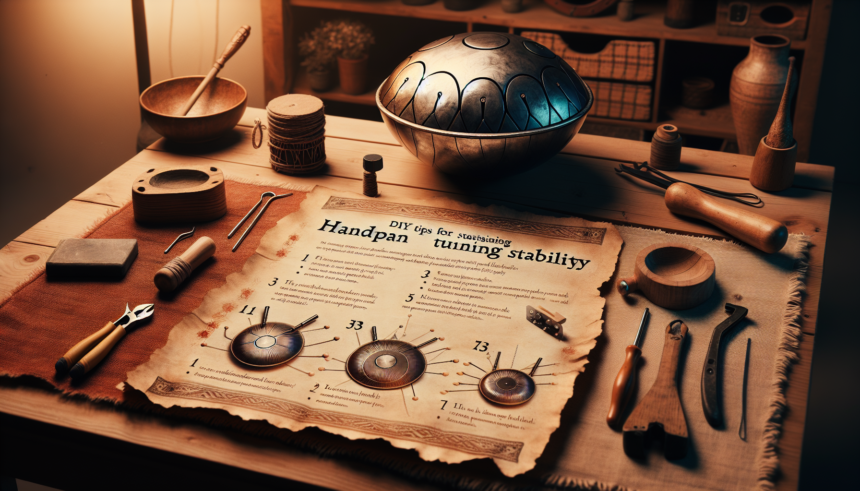<!DOCTYPE html>
<html lang="en">
<head>
<meta charset="UTF-8">
<meta name="viewport" content="width=device-width, initial-scale=1.0">
<title>DIY Tips for Sustaining Handpan Tuning Stability</title>
<style>
body {
font-family: Arial, sans-serif;
line-height: 1.6;
}
h2, h3 {
color: #2c3e50;
}
</style>
</head>
<body>
<h2>Introduction</h2>
<p>
Handpans are unique and delicate musical instruments that offer a meditative and mystical sound. These instruments, appreciated by musicians around the world, require special attention to maintain their tuning stability. While regular professional tuning is advisable, there are several do-it-yourself (DIY) tips you can apply to help sustain the tuning stability of your handpan. This guide provides insight into these methods and underscores the importance of proper maintenance.
</p>
<h2>Understanding Handpan Tuning</h2>
<p>
Before diving into maintenance tips, it's crucial to comprehend what handpan tuning entails. A handpan is composed of several tone fields, each producing specific notes. These notes must remain in harmonic balance with each other, and any deviation can lead to detuning, affecting the overall sound and musicality.
</p>
<p>
The tuning process involves hitting and adjusting these tone fields to perfect their pitch alignment. An experienced tuner uses specialized tools to listen for and eliminate dissonance. However, conditions such as temperature changes, impacts, and time can lead to shifts in tuning, necessitating attention to maintain optimal performance.
</p>
<h2>DIY Tips for Maintaining Tuning Stability</h2>
<h3>1. Manage Temperature and Humidity Levels</h3>
<p>
Handpans are particularly sensitive to temperature and humidity fluctuations. These environmental factors can alter the metal's properties, leading to sound variations. To mitigate these effects, store your handpan in a stable, climate-controlled environment. Avoid leaving it in a car or directly in sunlight for extended periods. Using a dehumidifier, especially if you live in a humid area, can also contribute to maintaining tuning stability.
</p>
<h3>2. Use a Quality Handpan Bag or Case</h3>
<p>
Investing in a high-quality, padded handpan bag or case provides considerable protection against physical shocks and environmental changes. These cases can prevent unwanted impacts and scratches while offering thermal insulation to help stabilize the instrument's temperature. Look for cases with reinforced padding and solid closure features to ensure the best protection.
</p>
<h3>3. Regular Cleaning and Maintenance</h3>
<p>
Dust, dirt, and oils from your hands can accumulate on the surface of your handpan, affecting its resonance. Clean your handpan regularly using a soft, microfiber cloth. Avoid harsh chemicals or abrasive materials; instead, use light oil, such as mineral oil, sparingly to clean. This approach not only preserves the finish but also aids in rust prevention and keeps the notes clear and resonant.
</p>
<h3>4. Mindful Playing Techniques</h3>
<p>
The way you play your handpan affects its tuning over time. Use gentle, controlled strikes with your fingers or the heel of your hand rather than hard hits or forceful techniques. This minimizes stress on the tone fields and reduces the risk of causing dents or other damage that could affect tuning. Practicing proper techniques ensures longer tuning stability and a consistent sound quality.
</p>
<h3>5. Positioning and Storage</h3>
<p>
When not in use, place your handpan on a secure, stable flat surface or in its case. Ensure that it is positioned away from edges where it could be knocked over or fall. Storing it on a soft surface or using a dedicated handpan stand will safeguard it from accidental impacts. Keeping your handpan in its case when not in use is the best practice to protect it from environmental factors and physical damage.
</p>
<h3>6. Limit Exposure to Harmful Elements</h3>
<p>
Elements such as saltwater, sand, or dust can have detrimental effects on a handpan. If you live by the ocean or frequent sandy environments, be extra vigilant about cleaning and protecting your handpan. Salts can corrode metal, while sand can scratch the surface or become lodged in crevices. Regularly inspect your instrument for any signs of damage and address them promptly.
</p>
<h2>Conclusion</h2>
<p>
Maintaining the tuning stability of a handpan involves several DIY practices that, when consistently applied, can significantly prolong the instrument’s life and sound quality. By controlling environmental factors, ensuring physical protections, employing proper playing techniques, and regularly cleaning the instrument, you can enjoy optimal performance. Although these tips are valuable, a professional tuning is recommended periodically to address deeper tuning issues and keep your handpan sounding its best.
</p>
<h2>FAQs</h2>
<h3>1. How often should I have my handpan professionally tuned?</h3>
<p>
It is generally advised to have your handpan professionally tuned every one to two years, depending on how frequently you play and the environmental conditions in which the handpan is kept.
</p>
<h3>2. Can I tune my handpan by myself?</h3>
<p>
While some resources suggest DIY tuning techniques, it is not recommended for beginners without experience. The tuning process is intricate and requires specialized tools and skills that professional tuners possess.
</p>
<h3>3. How can I tell if my handpan is out of tune?</h3>
<p>
Signs that your handpan may be out of tune include dissonant or sour notes, difficulty in achieving a clear sound, or inconsistency in tone quality. A trained ear can detect even subtle changes in pitch.
</p>
<h3>4. Will playing with mallets affect my handpan's tuning?</h3>
<p>
Playing with mallets can increase the risk of detuning if not done with care. Use soft, felt-ended mallets designed specifically for handpans, and play gently to minimize potential damage.
</p>
<h3>5. Are there specific materials advised for cleaning my handpan?</h3>
<p>
Yes, always use a soft, lint-free microfiber cloth for cleaning your handpan. Apply a light layer of mineral oil to prevent rust and ensure a clean surface without damaging the instrument's tone fields.
</p>
</body>
</html>DIY Tips for Sustaining Handpan Tuning Stability

Leave a comment




